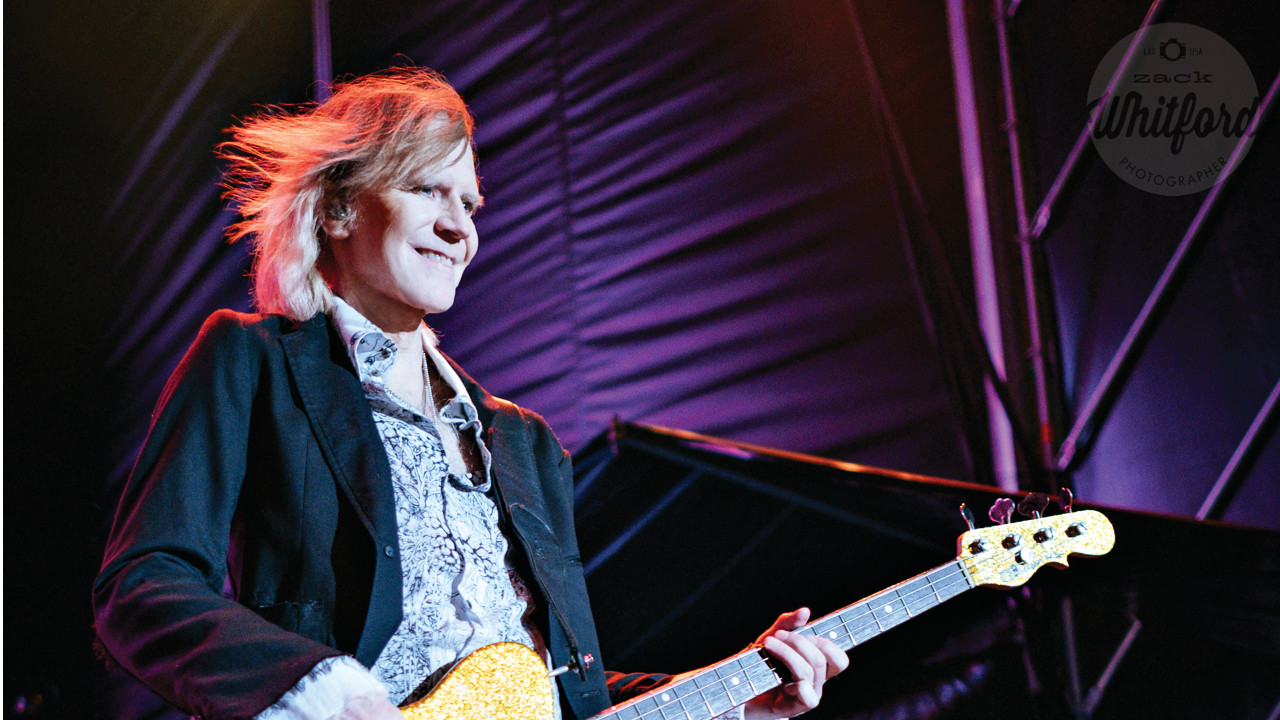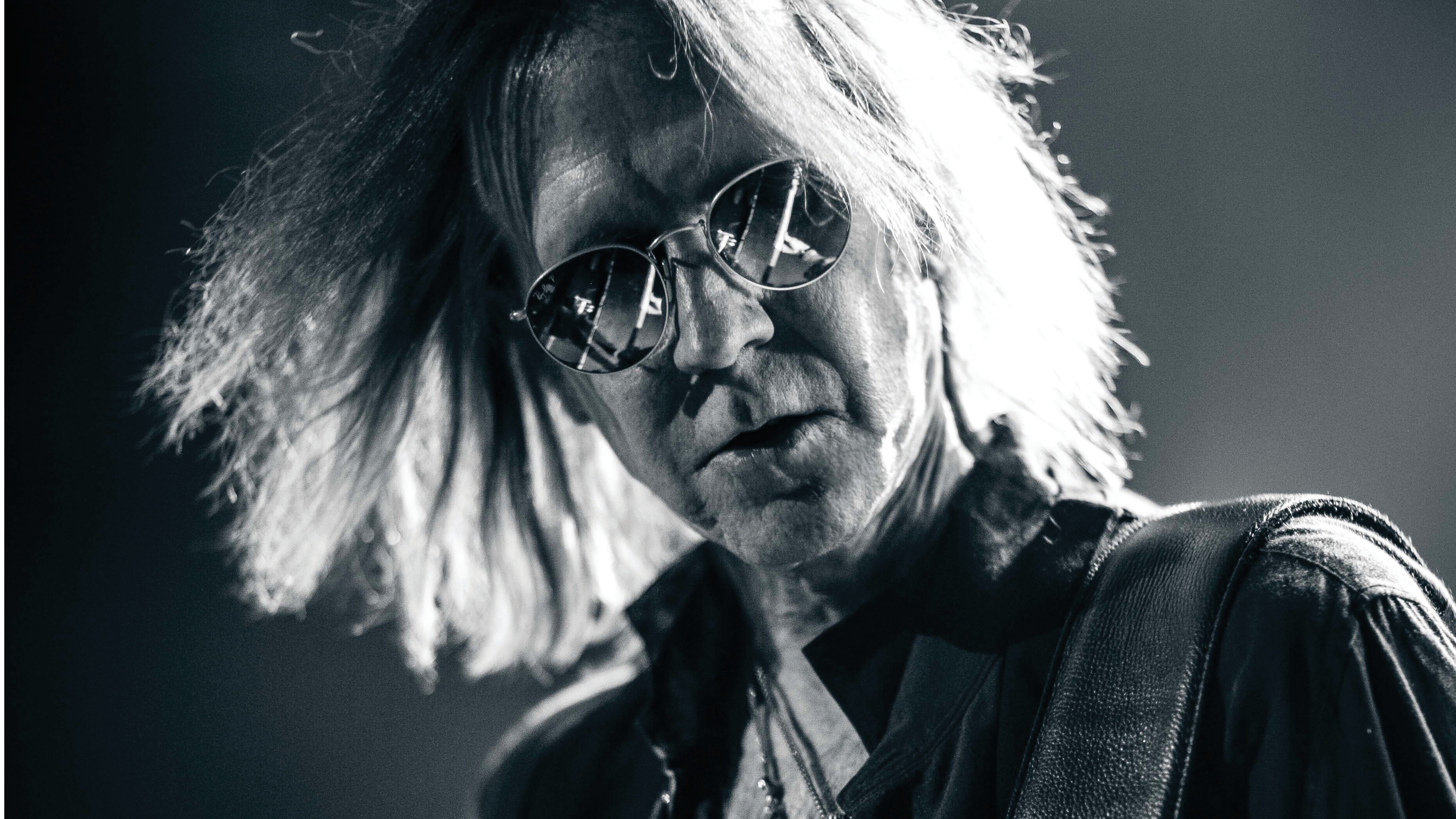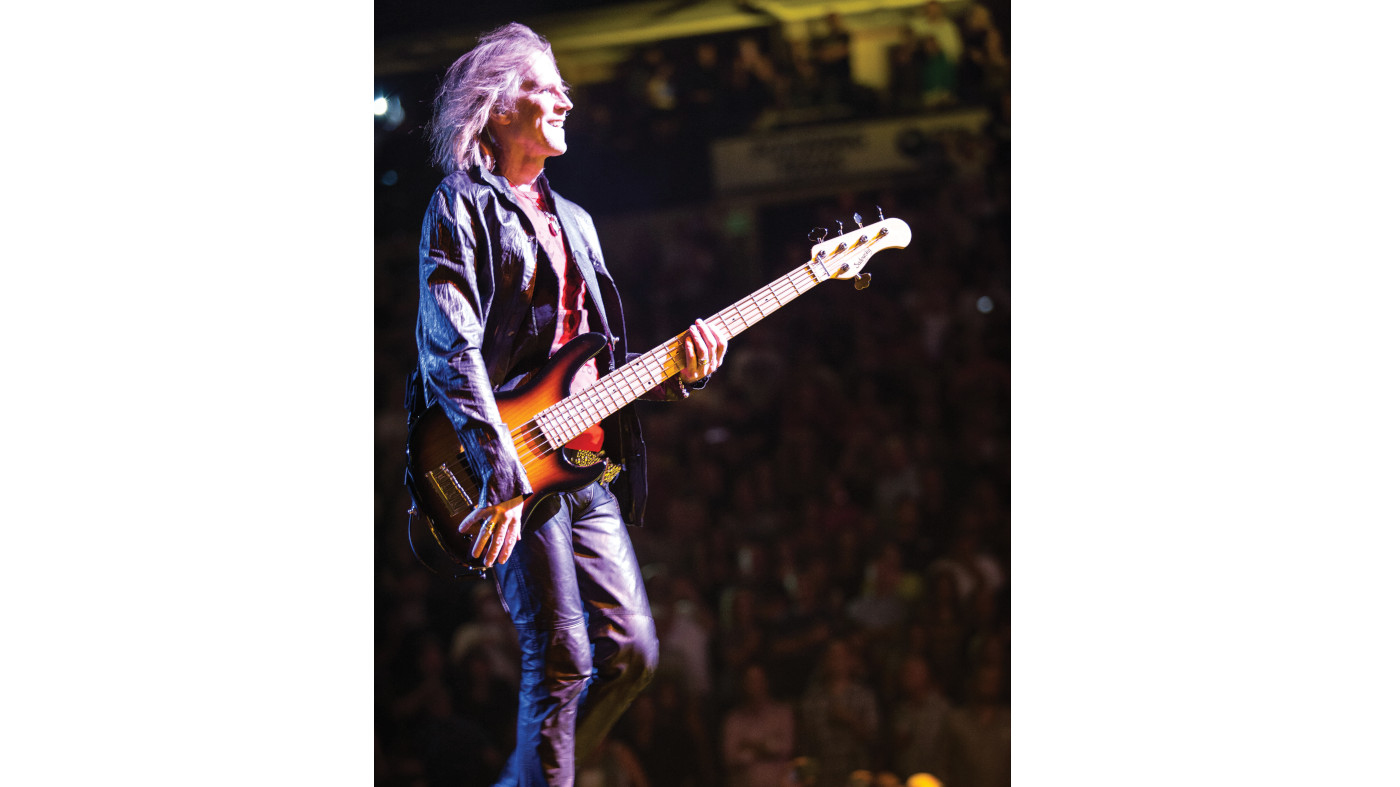Aerosmith’s Tom Hamilton: “I think that nowadays we’ve all become a little better at having respect for each other’s soft spots”
The bassist for the multi-platinum rockers reviews his near-50-year career

Normally we ignore press releases that run “Aerosmith - Steven Tyler (vocals), Joe Perry (lead guitar), Brad Whitford (guitar), Tom Hamilton (bass) and Joey Kramer (drums) - are a living piece of American music history” as made-up fluff from an overcaffeinated PR intern.
Not this time though; the claim is completely accurate. After all, if you’ve sold 150 million albums, won a stack of Grammys, Billboard and MTV Video Music Awards, nabbed a Soul Train award for Best Rap Single (yep) and produced your biggest show ever after half a century on the road, you’ve earned a few titles here and there.
Aerosmith are currently enjoying a residency in Las Vegas, mostly at the city’s Park Theater, while eyeing their 50th anniversary, which is just over the horizon in October 2020. “America’s Greatest Rock’N’Roll Band”, as the press release has it, have come up with a phenomenal technical array for the shows.
Without going into too much detail, two companies - THX and L-Acoustics, the former of which you may recognise from Star Wars - have partnered with the band to supply the world’s first THX Certified live performance presented in L-ISA Immersive Hyperreal Sound.
But how does the bass sound? Let’s ask Tom Hamilton, now 67 years old and, we’re very glad to say, on frisky form despite a brush with cancer a few years back...
I absolutely get off playing live. You have to look at things from the fan’s point of view
How much fun is the residency in Las Vegas, Tom?
“I can really feel myself and the band growing into this way of gigging. It’s starting to feel like home. Plus, I love the fact that we can have this monstrous production. I’ve always been into the eye-candy aspect of rock shows. I have absolutely no worries about the production distracting the audience from the music.”
Want all the hottest music and gear news, reviews, deals, features and more, direct to your inbox? Sign up here.
Do you still get excited at the prospect of performing?
“I absolutely get off playing live. You have to look at things from the fan’s point of view. I love to look out in the audience and see the look on people’s faces who may be seeing us for the first time.”
How do you stay fit on the road?
“I could probably spend more time in the gym, but I do have a trainer to keep me in shape. We’re in Vegas for an extended period now, so I have an exercise bike and some weights. I use them regularly. Honest! Seriously, staying in shape definitely shows up when it comes time to hitting the stage or even just practising.”
Do you warm up pre-show?
“It’s all calisthenics: getting the muscles warmed up. Lately I’ve been going over all the songs in the set, even the ones we’ve been playing over and over for years. I start to find that there are a lot of parts that I thought I was playing well, and realise that I could play them a lot better. It sounds like it would be boring, but it isn’t. It just shows you that there’s always new ways to get better and as a result have more fun!”

Gallien gear
What gear are you using these days?
“Since I’m in a band with two guitar players it’s important that I have a clear, punchy, percussive sound. The Gallien Krueger amps I’ve been using for a long time now make it easy for me to get that sound. I need amps that are relatively simple to use without a lot of redundant controls. Obviously, the cabinets need to be part of the formula, as well. I use primarily G&L ASAT basses. They remind me of my favourite bass of all time - my early-60s stack pot Jazz. It’s the one I used to record Sweet Emotion and all the rest of the Toys In The Attic (1975) and Rocks (‘76) albums.”
Why choose G&L for your signature bass?
All of the G&L stuff is such high quality, and they look really cool. I like that the company likes to stick to its mission
“G&L was one of Leo Fender’s companies, so a lot of his viewpoint on sound comes through. I like active basses, and the neck on the ASAT is slender like a Jazz. All of the G&L stuff is such high quality, and they look really cool. I like that the company likes to stick to its mission; I don’t feel them trying to expand and cash in. I went to the factory one day, and they have Leo’s office exactly as it was when he spent his last day there. They say a cluttered room can be the sign of a creative mind - and that definitely describes his workspace.”
Tell us about the Hamiltone pickups on your G&Ls, and any effects that you use.
“All I know is that it sounds warm and fat and clean. No pain-in-the-ass overtones! I pretty much pick up a bass and play it as it is, although I’m always trying to find the ideal overdrive or distortion sound. I just never find one I want to stick with. Having said that, there’s a company called Source Audio that has a bass effect pedal that’s real close. Maybe when I go home on break, I’ll get it out and work with it some more.”
How do you go about finding your tone?
“I go in there with all knobs up. I love Sadowsky basses too. Roger once made me one with nothing but a volume knob. There it is!”
Do you ever break out any vintage basses?
“My tech just took an old Precision of mine, tuned it up and got the neck all dialled in, and now I’m using it for a few songs in the set. It’s interesting to play a bass that has been used on so many great records. It’s actually shaped the role of the bass guitar in rock music. Something about the way it feels and sounds makes you play a certain way, and you start to feel yourself playing like things you’ve heard all your life.”

Rhythm kicks
Looking back, what was it like to play in a rhythm section with Steven on drums in the early days of the band?
“Steven was playing drums and singing lead in his band before joining up with Joe and I, a situation that he hated. When he called and said he would come up to Boston and join us, I think he was under the impression that we wanted him to play drums, but we promptly reassured him that the drums could stay home so he could be out front where he belonged. Joe and I had seen him perform in some of his other previous bands as a lead singer and were blown away. He has a great feel as a drummer and has plenty of knowledge when it comes to creative ideas, but his touch isn’t as heavy and powerful as Joey’s. There’s a lot of back and forth between those guys when it comes to ideas and the whole band benefits from it.”
Which album from the Aerosmith back catalogue are you most proud of?
I’m proud of Toys In The Attic and Rocks. I was able to take my playing up a notch and also kick some ideas into the songwriting department
“Obviously, I’m proud of Toys In The Attic and Rocks. I was able to take my playing up a notch and also kick some ideas into the songwriting department. But I also feel good about my playing and the sound I was able to get on the Pump album. I used my early Music Man for most of that album except for the ballad, What It Takes, where I used a Hofner.”
When Aerosmith fragmented in the early 80s, did you consider joining other bands?
“It didn’t dawn on me that the band was essentially over. We had a new hot guitar player named Jimmy Crespo who could play his ass off and write, and I thought we would finish the album we were forcing into existence, go on the road and everything would be the same, but it wasn’t. It just kept deteriorating until one day I was watching this new channel called MTV - and realised that we would probably never be part of it.”
Did you ever record sessions during the various Aerosmith sabbaticals?
“The only work I’ve done outside of the band was with the Thin Lizzy guys in 2016. They had a band called Black Star Riders, but decided to do a Thin Lizzy reunion tour to commemorate the thirtieth anniversary of Phil Lynott’s death. I got a call to see if I was interested in playing bass - so I can say that, briefly, I was a member of Thin Lizzy. They’re awesome guys. I schooled the material until I thought I had it down, but when I got to our first rehearsal, I realised I still had a ways to go before the songs were really burned into my brain. They were really patient, thank God, and helped me get over the hump. At the end of the first day of rehearsal, Scott Gorham came over and said: ‘Do you ever use a pick?’ I said ‘No, it’s easier for me to get a strong fat sound with my fingers’ to which he said ‘You should try it some time’. I thought ‘Okay, maybe I might’. It wasn’t until I got back to my hotel room that it dawned on me that Phil used a pick! All those great bass parts of those great songs were written by a pick player... The next day I made sure I had a pocket full.”
Who's who?
Your bass influences include McCartney, Entwistle and John Paul Jones. Who else do you admire?
“When people ask me that question I always forget to mention Chris Hillman from the Byrds and Jack Casady from Jefferson Airplane. Chris was a very musical player. Check out his playing on a song called Renaissance Fair. Jack was freaky, and I mean that in the most complimentary way. They put out a live album called Bless Its Pointy Little Head. His playing is like no other bass player I’ve ever heard. Weird and powerful. Psychedelic! I can’t think of many more recent players by name, but I’ve heard many that impress me. I’d have to say the guy in Greta Van Fleet is pretty damn good. Eric from Jane’s Addiction is really good, as well as the guy from Soundgarden - and don’t forget Jeff Ament from Pearl Jam. My wife and I always have their XM channel on, so I’ve had the pleasure of hearing a lot of his playing.”
Which albums influenced you the most as a bassist?
It was insane the way Entwistle, Townshend and Moon could all go off in 100 different directions and then, bang, come right back in for Daltrey’s vocal
“That’s a question that’s almost impossible for me to answer, because I never liked albums because of the bass player. Having said that, either of the first two Led Zeppelin albums. The bass and the drums mesh in a way that make it impossible to stand still. Another would be the live Who album, Live At Leeds. That album was so amazing. It was insane the way Entwistle, Townshend and Moon could all go off in 100 different directions and then, bang, come right back in for Daltrey’s vocal. I also really liked the first few Police albums. Sting was really great at the way his bass parts would drive the atmosphere of the song in combination with Andy Summers and Stewart Copeland.”
How do you write your bass-lines?
“I like to be able to spend time and find the little places where I can have a voice. Along with that, I’ve learned over the years to be okay with other guys in the band throwing a suggestion my way. I think the most important thing is to serve the song. I’ve never been one to like a record simply because of what the bass player is doing. It’s all about the song. Having said that, I do like to have time on my own with a song to come up with ideas. I don’t work really fast, which is why session work would probably never have worked for me. Joey and I have done a lot of work together, just the two of us. We can work at our own pace and have plenty of time to focus on certain details when there’s nobody else around.”
Are you a keen slap bass player?
“I just never felt the urge to join in to the slap bass thing, although I’ve used little bits of it here and there, like on the bridge in Love In An Elevator. Don’t get me wrong, a lot of people are really creative in that style. Years ago I was lucky enough to be in the front row at a Sly & The Family Stone concert, and sat right in front of Larry Graham - who was essentially the first one who played that style.”
I have a collection of songs that I’ve been expanding for a long time. Most of them are close to being finished
Do you have any unfulfilled musical ambitions?
“I have a collection of songs that I’ve been expanding for a long time. Most of them are close to being finished as far as lyric ideas, and I have a good friend who absolutely kills on Pro-Tools and Logic, so I have pretty good demos. Some could possibly be Aerosmith songs, and a lot of them probably couldn’t. We put out an album called Music From Another Dimension! in 2012, where I was able to fulfill some of my musical dreams. I wrote a song called Tell Me, which was my first time writing lyrics and hearing them being sung by Steven. It was so inspiring working with him when he cut the vocal.
“On the deluxe version of the album there’s a song I wrote called Up On The Mountain, which I actually sang as a duet with Steven. My first time ever singing lead on a song! So those two songs were the fulfillment of some dreams I’ve had for a long time. As far as the other material I have saved up, either it’ll become Aerosmith material and Steven will sing them, or I’m going to have to find somebody else to do it. I had cancer in my throat a while back, and they used heavy doses of radiation to get rid of it. The after-effects of that keep coming, so my ability to sing them is fading fast.”
With Aerosmith approaching its 50th anniversary, has anything changed after all these years?
“I think that nowadays we’ve all become a little better at having respect for each other’s soft spots. It probably comes from us all just being grateful that we have this band, and all the excitement and adventure that goes with it, and an appreciation of how easy it would be to lose it.”
Is there still new ground to cover?
“I would never shut my eyes and nap on what we’ve accumulated over all these years. There are still places in this world where there are Aerosmith fans that have never heard us live. This band is playing better and better the more we do it. It’s not like we’ve done it all. There’s still Cuba, for instance. I’d absolutely love to play there. I’ll always be open to the idea that there might be another record in our future. Why rule it out?”

